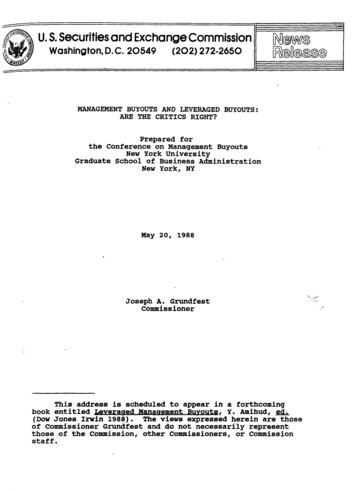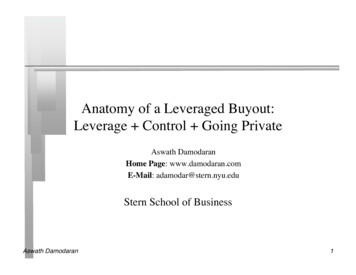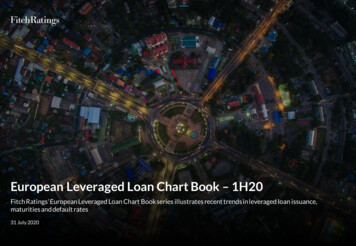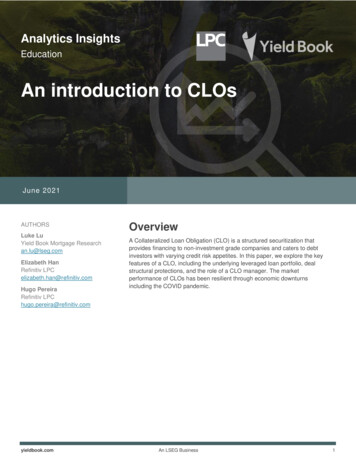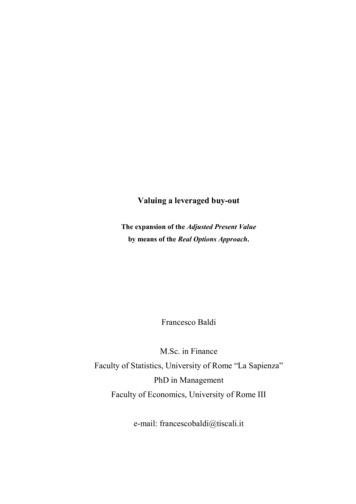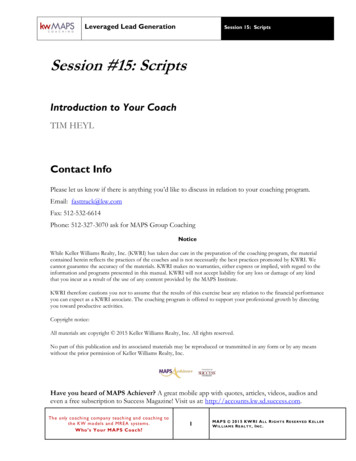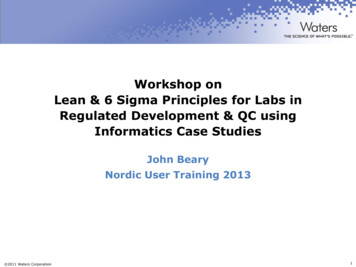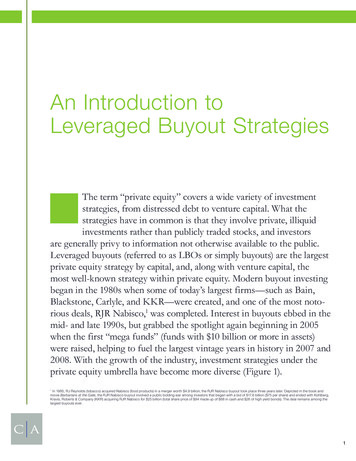
Transcription
An Introduction toLeveraged Buyout StrategiesThe term “private equity” covers a wide variety of investmentstrategies, from distressed debt to venture capital. What thestrategies have in common is that they involve private, illiquidinvestments rather than publicly traded stocks, and investorsare generally privy to information not otherwise available to the public.Leveraged buyouts (referred to as LBOs or simply buyouts) are the largestprivate equity strategy by capital, and, along with venture capital, themost well-known strategy within private equity. Modern buyout investingbegan in the 1980s when some of today’s largest firms—such as Bain,Blackstone, Carlyle, and KKR—were created, and one of the most notorious deals, RJR Nabisco,1 was completed. Interest in buyouts ebbed in themid- and late 1990s, but grabbed the spotlight again beginning in 2005when the first “mega funds” (funds with 10 billion or more in assets)were raised, helping to fuel the largest vintage years in history in 2007 and2008. With the growth of the industry, investment strategies under theprivate equity umbrella have become more diverse (Figure 1).1In 1985, RJ Reynolds (tobacco) acquired Nabisco (food products) in a merger worth 4.9 billion; the RJR Nabisco buyout took place three years later. Depicted in the book andmovie Barbarians at the Gate, the RJR Nabisco buyout involved a public bidding war among investors that began with a bid of 17.6 billion ( 75 per share) and ended with Kohlberg,Kravis, Roberts & Company (KKR) acquiring RJR Nabisco for 25 billion (total share price of 94 made up of 68 in cash and 26 of high yield bonds). The deal remains among thelargest buyouts ever.1
Figure 1. Private Equity Investment StrategiesPrivate Equity 1.0 (1985–2005)Plain VanillaPrivate Equity(LBO)MezzanineVenture CapitalDistressedValue Oriented(May include leverage as strategy)Plain Vanilla(Leverage)Growth Oriented(Low to no leverage)Private Equity 2.0 (2005–today)Plain VanillaBuy-and-BuildPrivate Equity(LBO)Operational PEBuy-and-BuildSector FundsMezzanineGrowth BuyoutsCapital SolutionsGrowth EquityDistressedUncorrelatedValue Oriented(May include leverage as strategy)Venture CapitalPlain Vanilla(Leverage)Growth Oriented(Low to no leverage)Source: Cambridge Associates LLC.2
Today’s private equity firms are increasingly differentiating themselves throughsourcing, financing, analyzing, andoperating companies, as well as throughsector specialization. For example, whiletraditional buyout funds primarily targetedcompanies in industries that producedpredictable cash flow (like manufacturing),starting in the late 1990s, funds wereformed to focus on the technology sectorgiven the industry’s maturation during thedecade. Today, a number of funds specializein specific sectors, including consumer,energy, financial services, health care, andtechnology. Figure 2 describes the spectrumof private equity strategies in more detail.Figure 2. Illustrative Spectrum of Private Equity & Venture Capital StrategiesTarget Net Return10%LeverageTargetRisk %Distressedfor Control20% PrivateEquity(LBOs)GrowthEquityVenture CapitalLate StageVenture CapitalSeed/Early StageInvestmentsin primarilypublicly sthrough debt orequityEquity capitalplus third-partyleverage typicallyfunds the controlpurchase of anoperatingbusiness withcash flow.Control ownersmay enhanceoperations andvalue of companyOften firstinstitutionalcapital in highgrowth “bootstrapped”companies.Capital fundsfurther growth andpartial payout offounder. Targethigh growthmarkets.Profitability maydecline withgrowthInvestments oftenfund build out ofmanagement andbusinessInvestments funddevelopment ofinnovative ideasor technologyMature businesswith debt atimpaired valuesMaturebusinesses,distressed eitherfinancially ororganizationallyMature business;revenue/profitability Mid teensMid teensMid teensMid/High teensHigh teens/low20sHigh teens/low20sLow – ModerateModerateModerateModerateModerate – HighModerate – HighLow – ModerateLow – ModerateModerate – HighLow – ModerateNoneNoneSecondariesFunds of FundsSource: Cambridge Associates LLC.* Exposure can be gained through hedge funds.3
In this report we discuss LBO strategiesin depth and touch on distressed andgrowth equity strategies. We review typesof buyouts, the buyout investment process,returns, fees, risks, and recommendationsfor conducting due diligence.In short, buyout managers (often calledGPs for general partners) generally invest inmature companies they deem undervalued,with the aim of improving them and thenselling for a profit. Purchases are fundedwith a combination of equity and debt(“leverage”), which can help boost returnsto the equity investor. Investments aretypically exited through a sale to a strategicor financial buyer or through the publicmarkets via an initial public offering (IPO).Investors in buyout funds, called limitedpartners (LPs), commit during the fundraising period, contribute capital as the fund“calls” it for investments, and receive capitalback when investments are sold and the GPdistributes capital from the proceeds.Multiple risks are associated with allprivate equity investing, including buyouts.Illiquidity and blind pool risk, discussedin this report, could be a concern for LPs,and many factors contribute to the successor failure of an investment, including issuesspecific to the target company, the purchaseprice, sector, geography, and macroeconomicenvironment. Healthy exit environments(active merger & acquisition activity andstrong public markets) also help to drivepositive exits for buyout funds. Beforecommitting to a buyout fund, potential LPsconduct due diligence on the investmentopportunity, focusing on the firm and fundmanagers, the fund’s investment strategy,investment performance, and fund terms.What Are Buyouts?In a leveraged buyout transaction, a fundbuys the equity or the assets of a companyfor a negotiated price, using a mixtureof equity and debt, otherwise known asapplying leverage. The debt portion of thetransaction includes senior secured debtsupplied mainly by banks (willing to lendbecause LBO targets have steady cash flowand because the banks have a claim on theunderlying assets of the business), as well ashigh-yield debt and debt with equity characteristics such as convertible debt, stock, orwarrants. Buyout funds target more established companies than their venture capitalcounterparts and focus on improvingoperations, often by cutting costs, sellingunprofitable businesses, and recruiting keyexecutives. Targeted businesses typicallyhave enterprise values between 100 millionand 10 billion (a range that changes overtime), and investments are generally sold tostrategic or financial buyers or taken publicthrough a public stock offering.Types of Buyouts. The five main typesof buyouts include management buyouts,operational buyouts, value buyouts, growthbuyouts, and turnarounds. Figure 3 summarizes their key characteristics.In a management buyout, companymanagement and a private equity fund buythe company from the existing owners withthe intention of implementing the management team’s plan to operate the businessmore effectively. In this type of buyout, theinterests of the management team and thebuyout fund are aligned.In an operational buyout, the privateequity fund managers and/or their oper-4
Figure 3. Key Characteristics of Buyout lBack managementplan to improveoperations which,typically, currentowners do notsupportIncreaseoperational cashflowOptimize capitalstructureassuming stablecash flowsIncrease revenue;expand services,product, geographicfootprintRestructure; bringcompany back tocash flow positiveFundingEquity contributedby buyout fundsand managementteam; debt frombanksDebt and equityDebt and equityDebt and equityEquity; may alsouse asset-basedloans; frequentlycash flow loansare not availableOperationalInvolvementLittle by privateequity investorsSignificantNoneSomeDirectCriteria forSuccessInvestmentbanking skills infinancialstructuring andvaluation; ability toevaluate andpartner with owledge, andinvestmentbanking skillsState of currentfinancial markets;deal structure;ability to analyzecompany’s valueMay includeindustry expertise,operationalexpertise, ability tostructure financingappropriately andengineer strategicacquisitionsRestructuring andinvestmentexperienceLeverageYesYesYesLess than in othertypes of buyoutsLimitedTargetEstablishedcompany whosemanagementteam seeksownershipEstablishedcompany in needof anies inunconsolidatedsectors and/orgrowing sectorsTroubled ordistressedbusinesses;orphaned orundermanageddivisions orbusinessesSource: Cambridge Associates LLC.5
ating partners/proxies become directlyinvolved in the operations of the portfoliocompany. The goal of such involvement isto increase the cash flow produced fromthe company’s operations through variousstrategies, such as creating efficiencies andcutting expenses through reduction in workforce. This type of buyout requires buyoutprofessionals with specific operating experience and knowledge of various industries.In a value buyout, the GP does not becomeinvolved in the operations of the portfoliocompany. A value buyout is a pure financialplay where the buyout fund expects tobenefit from applying leverage to a companyand lowering the cost of capital, whichshould increase the cash flows to the equityowner. The success of a financial buyoutis largely dependent on current financialmarkets, the structure of the deal, and theability to analyze the value of the company.In a growth buyout, the private equityfund seeks to capitalize on growth inthe revenues of the portfolio company.These funds often seek to create revenuegrowth through market share gains, overallmarket growth, distribution or productline expansion, and market consolidationand acquisitions. Targeted companies aregenerally less mature than in more traditional buyout transactions. Skills requiredoften include the ability to offer operatingenhancements, engineer strategic mergers,or structure financing for the growth ofthe company.In distressed and turnaround investments, the private equity fund typicallyacquires control in troubled or underperforming companies or divisions with thegoal of improving the company’s cashflows. Targeted companies might be goodcompanies with bad balance sheets, suchas in a distressed-for-control transaction,when the company is no longer able toservice its debt. In this case, the turnaround (or distressed) fund purchases thefulcrum security—which is the part of thecompany’s capital structure that will controlit after a reorganization, usually in the formof equity (though identifying the fulcrumsecurity’s location in the capital structureis not a straightforward task)—and worksthrough the restructuring process as a keymember of the creditor committee. Thiscommittee typically leads the process torestructure the balance sheet, with theinvestors in the fulcrum security typicallyreceiving equity as well as some debt inthe restructured company. Turnaroundsare similar to operational buyouts but withmore severe cash flow problems. In manycases, portfolio companies can be acquiredat below liquidation value (value of assets).Other examples of turnarounds couldinvolve businesses in need of restructuring due to an outdated business model(e.g., brick-and-mortar retail facing onlinecompetition) or workforce issues includinglabor/union contracts and pension plansthat burden the company from a coststandpoint. Skills generally required forturnaround funds include restructuring,legal, and investment experience.6
The Buyout Investment ProcessRegardless of the type of buyout, all buyoutfunds generally follow a similar process,depicted in Figure 4.Figure 4. Buyout Investment ProcessIdentifyCompanyConduct DueDiligencePre-PurchaseArrive atPurchasePriceStructure theTransactionHold andImproveCompanyPost-Purchase(typically threeto five years)Pay DownDebtExitSource: Cambridge Associates LLC.The first step in the investment process isdeal sourcing, or identifying a company,which can be done through proprietarychannels or auctions. Firms that focus onsmall- and mid-cap companies tend to useproprietary sourcing, such as cold calling,database mining, and industry conferences,while funds focused on large- or mega-capcompanies are more likely to find opportunities through auctions run by investmentbanks. Funds target a range of companies,from privately owned companies to publiccompanies (divisions, subsidiaries, or entirecompanies) that they will take private.Targets generally share characteristics likeundervaluation, largely unlevered balancesheets, strong management, valuable assets,and predictable cash flow.Once a company is identified, the buyoutfund will conduct due diligence, focusingon items such as the company’s marketposition, management, and financial performance. Through this analysis and financialmodeling based on growth and performance assumptions, the fund will arrive at apurchase price. The next step is to structurethe transaction using debt and equity tooptimize the capital structure.Post-investment, private equity firms seekto improve the portfolio company’s performance primarily by growing revenue andEBITDA, increasing operating margins,and helping to generate free cash flow thatcould be used to service and pay down thenew debt. While under private ownership,changes are often made to management andoperations, such as sales and business strategies. Private equity firms typically hold theircompanies for three to five years, dependingon market conditions and the performanceof the company.7
In the final stages of the process, prior toexiting the investment, debt is paid downas free cash flow improves, both because ofthe amortization requirements of the loansand to prevent cash building up on thebalance sheet, which is not an optimal useof funds. In this instance, the private equityfund might seek to issue dividends to theequity owners, depending on the termsof the financing, which might require debtpaydown prior to paying dividends. Investments are exited through a sale to a strategicor financial buyer or a public offering.Buyout Firm Investment StrategiesBuyout strategies have evolved from the“plain vanilla” buy-and-build investmentapproaches of the past. In today’s market,funds rely on more than financial engineeringand cutting costs. Firms differentiate themselves through sourcing; growth or valueorientation, sector, market, and geographicalexpertise; and operational experience. Abuyout fund’s investment focus can be characterized along a few simple dimensions.Portfolio company size. One of the keydifferentiators among buyout strategies isthe size of the targeted companies. Whilethe ranges for what are considered small,middle, and large companies have shiftedover time, in general, small-cap companiesare up to approximately 250 million inenterprise value (the value of the company’sequity, debt, and cash), mid-cap companieshave enterprise values up to 1 billion, andlarge-market companies are larger than 1 billion in size. In addition to enterprisevalue, other metrics used to determine acompany’s size might be EBITDA (earningsbefore interest, tax, depreciation and amortization) or revenue.Fund and investment size. Funds aretypically categorized by the average sizeof their equity investments, as well asthe amount of money committed to thefund. For example, smaller funds mightinvest as little as 5 million of equity intodeals and can be as small as 100 millionin committed capital. Mega funds couldinvest more than 1 billion in a transactionand have been as large as 20 billion incommitments.Growth or value. As discussed, typicalbuyout funds invest in undervalued companies and sometimes in businesses thatrequire significant change or “turnaround.”On the other hand, growth-oriented fundsinvest in profitable companies whoserevenue and EBITDA are growing by 20%or more. Similar to leveraged buyouts,growth-oriented funds vary in size, withcorresponding differences in the marketcapitalization of the target companies.Sector specialist versus generalist.Buyout and growth-oriented funds areincreasingly specializing in individualsectors rather than implementing moreopportunistic strategies. Today, there aresector-focused funds dedicated to a varietyof sectors, such as business and financialservices, consumer, energy, health care, andIT. A fund manager’s specialization mightalso be geographic in nature, such as Nordicregion, midwestern United States, or LatinAmerica, although larger firms tend to haveglobal mandates.Operational focus. Private equitymanagers have moved away from financial engineering and toward operationalexpertise. GPs now have a wide varietyof experience among their investment8
first three to six years of the partnership’sterm is the investment period when mostof the committed capital is called (or drawndown). Figure 5 illustrates the effect onreturns caused by the cash flow trajectory ofLP contributions (capital calls and fees) inthe early years of a partnership followed byLP distributions in later years.2teams. In addition to former investmentbankers and other investment professionals,GPs may be former company executives, business development professionals,medical doctors, and other types of sectorexperts. Another tactic for funds is tobuild “benches” of experts to help improvecompanies once they are acquired.Buyout returns are driven by the initial pricepaid and degree of leverage employed, theholding period, the economic success of thebusiness during the holding period, and thecompany’s market value at the time of sale.The health of the public markets and themerger & acquisition market both factorin to the buyout fund’s ability to sell thecompany and realize a return. Buyout fundscan also boost returns through improvingBuyout ReturnsPrivate equity funds are blind pools (i.e.,the individual investments are not identifiedprior to the LP’s commitment) “raised”with capital commitments in a fund-raisingprocess. LPs commit capital to privateequity partnerships formed by a GP, orthe investment team/manager of the fund.When the GP identifies an investment, it“calls” capital from the LPs. When the GPexits or sells an investment, it “distributes”the proceeds from the transaction to LPs.The life of the partnership is generally tenyears with the potential for extensions. The2In the first few years of a fund, returns are usually negative as a result of the LPcontributions and fund expenses, coupled with less movement in the valuation ofportfolio companies. Later in the life of funds, investments are typically revaluedbased on improvements (margins, cash flows, business models) and then exited,which leads to an upward movement in returns when the exit is profitable. The“J Curve,” a term often heard in conversations about private equity, refers to thisphenomenon of the LP’s internal rate of return (IRR) going from negative to positiveover time.Figure 5. Illustrative Cash Flow for a Private Investment FundReturn RealizedReturn of CapitalInitialInvestmentYears012345678910Drawdown PeriodSource: Cambridge Associates LLC.Note: Illustrative cash flow is calculated from the Cambridge Associates LLC Private Investments Exposure Model, based on astarting total pool value of 800mm and 2% pool growth rate.9
the company’s operations (revenue,EBITDA, margins) or selling undesirable or nonessential divisions. Earningsgrowth should lead to increased value forthe company, and proceeds from sellingdivisions could be used to pay down debt orinvest in strong performing operations.Figure 6 further illustrates the variouscomponents of value creation in an LBOtransaction. The first bar refers to theequity contribution of the company’spurchase price and the last to the equityvalue realized at exit (when the fund sellsthe company). The difference between thelast bar and the first is the value created(or return), in this case 150, which iscomposed of the middle three bars:EBITDA growth, multiple expansion,and net debt paydown. In this example,EBITDA growth contributed 94 of the 150 return. Multiple expansion, or theGP’s ability to sell the company at a higherEBITDA multiple than it paid at acquisition, contributed 48 of return. WhenEBITDA has increased during the holdingperiod and the multiple at exit is higherthan that paid at acquisition, multipleexpansion is a larger component of thevalue created by the private equity fund. Bypaying down debt, the private equity fundincreases its equity in a company.Figure 6. Illustration of Value Creation in a Leverage Buyout Transaction 300 250 48 8 250Net DebtPaydownRealized /Fair Value 94 200 150 100 100 50 0Initial EquityEBITDAGrowthMultipleExpansionSource: Cambridge Associates LLC.10
FeesGPs are compensated through two types offees: the management fee and their share ofprofits, known as carried interest or carry.For many funds, the fee structure tends topeg management fees at about 2.0% in thefunds’ investment period. Following theinvestment period, fees typically transitionfrom being based on committed capital tobeing based on the amount invested in portfolio companies. The carried interest chargedby funds varies, with 20% a frequently usedamount. Many funds include a “hurdle rate”for their carry. Hurdle rates require the fundto earn a minimum return to LPs, only afterwhich does the GP receive the specifiedcarried interest.Risks Associated WithPrivate InvestmentsA number of risks are associated withprivate equity strategies, including buyouts.For example, investments are illiquid for anumber of years, and most types of privateinvestments offer little or no current incomeflow. As a result, the return is dependent onthe eventual sale of the company, the returnof the GP’s cost basis (i.e., the current investment amount), and the realization of capitalgains. The use of leverage also presents risks,making the investment more vulnerable tochanges in the financial markets (e.g., risinginterest rates and/or declining valuations).Buyouts predicated on the restructuringof operations will tend to be less exposedto shifts in the financial markets, with theprimary risks arising from macroeconomicconditions and industry- or company-specificfactors, such as regulatory changes, increasedcompetition, or product obsolescence.Another component of risk in an LBO orprivate equity investment is the purchaseprice, or how much a fund pays for an asset.Various scenarios can drive purchase pricestoo high and result in lower-than-expectedreturns. For example, if assumptions usedto calculate the purchase price proveincorrect (or too optimistic), the fund willhave paid too much and will be at riskof losing money upon exit (realizing lessmoney upon exit than was paid at acquisition). Valuations (purchase prices) can alsobecome inflated when the LBO marketoverheats, as seen in the period leading upto the global financial crisis in 2008. Cheapcredit, an intermediated market (investmentbanker–led auctions), increased merger &acquisition activity by strategic buyers, andstrong public markets can all contribute toan increase in competition for deals andconcomitant increases in valuations (prices).When assessing market conditions forprivate equity, investors look at the paceof the industry’s fund raising, capital calls,and distributions. Exogenous factors, suchas the health of the public markets and theavailability of credit, influence all stages ofthe private equity investment process andcash flows.33We discuss the current environment, valuations, and our views on investing invarious private equity strategies in our monthly Asset Class Views publication.11
Due DiligenceThe investment due diligence process forbuyout opportunities (and private equitystrategies more generally) focuses on thefollowing key components: organization,investment strategy, investment performance, and fund partnership terms. Eachof these is discussed in more detail in thetext that follows, and Figure 7 summarizessome of the items evaluated during due diligence. Cambridge Associates recommendsLPs view each fund as a new opportunitythat should be diligenced in the same wayas prior funds have been—i.e., a decision toinvest in Fund IV should not automaticallybe a decision to invest in Fund V.Organization. When assessing the organization, a potential LP evaluates the firmhistory, the experience and compatibilityof the investment team (GP), the ownership and economics of the firm for itsemployees, and the investment process.Questions asked during this phase ofdue diligence focus on the strengths andweaknesses of the investment team, theappropriateness of the team’s experience toits strategy, and the specifics of the investment process.Established buyout firms are generallymanaged by a group of GPs that haveworked together in the buyout businessand can document their success in previousinvestments. Since established firms tendto be some of the largest, they control theFigure 7. Due Diligence: Illustrative List of Items to rformancePartners’ financial/operationalexperienceExperience investingor operating in thesectorPerformanceattribution, if trackrecord availableNetworks of seniorprofessionalsSourcing advantage/industryrelationshipsApplicability oftrack recordTermsPerformance-basedcompensationGP commitmentFirm ownershipand economicdistribution amongemployeesTeam cohesionJunior and backoffice supportLP-friendly termsValue creationstrategyUnderwritingdisciplineExit strategySource: Cambridge Associates LLC.12
greatest amount of capital raised and sothe majority of private capital continuesto be managed by experienced managers.Many new funds, particularly those thatare spinouts from larger firms, are also ledby GPs with substantial principal-investingexperience.which will be needed not only to evaluatethe business prospects of the potentialinvestment but also to assist in those areasduring the period of investment; and,finally, the industry expertise needed toanalyze the potential investment and toprovide access to deal flow.Although LPs may feel more comfortable with an experienced group raising afollow-on fund, they should ensure thatthe individual partners primarily responsible for particularly winning investmentsremain on board. In addition, carefulquestioning of the partners may reveal thatthe actual screening and analysis is nowbeing performed by new, less experiencedassociates in the firm. If less experiencedassociates and junior partners are involvedin decision-making at the larger firms, LPsshould understand fully the extent to whichcritical decisions are still made by the mostexperienced partners.Investment Strategy. The next elementof the due diligence process is an evaluation of the investment strategy, includingdeal sourcing, pricing discipline, sectorexpertise, structuring capabilities, valuecreation strategy (post-acquisition actions),and exit strategies. Questions about investment strategy focus on the partnership’sability to execute the strategy in the past,the repeatability of its sourcing process,and its purchase price multiples (purchaseprice/EBITDA) relative to peers and publiccompanies.Evaluation of the GPs’ experience is muchmore difficult in the case of emergingmanagers. Knowledge of how long and inwhat capacities the partners have knowneach other is crucial, because the ability towork well together is critical to the successof the partnership. To the extent membersof the new team have buyout experience,LPs should diligently identify the investments for which those individuals wereresponsible and the ensuing results. LPsshould also assess whether the new teamhas the skills needed for success. Amongthese are the financial experience requiredboth to assess the pricing structure of a dealand to assist the company’s managementduring a period of enhanced financial risk;experience in operations and marketing,Probable deal size (and, relatedly, whethertargets will tend to be public or private andlarge- or small-cap), industry emphasis,geographic concentration, and whetherthe financing will be concentrated inequity or debt all directly affect the level ofrisk and potential return of a given fund.Consequently, prospective LPs shouldanalyze the extent of a fund’s diversification in these critical areas to understandhow much risk the fund intends to incur.In addition, potential LPs cannot effectively assess the GPs’ ability to add valuewithout a thorough understanding of howthe proposed strategy is designed to exploitthe specific experience and expertise of thebuyout firm’s personnel.Lastly, for either established or emergingmanagers, the individual elements of the13
partnership must coalesce into a cohesiveteam and strategy. Do the individualpartners’ levels of experience, the profile oftheir earlier partnerships (if an establishedfirm), the makeup of the managementteam, the size of the fund, and the probablesource of their deal flow mesh with theirproposed investment strategy?Investment Performance. A review of thefirm’s investment performance at the fundand company levels is another critical partof the due diligence process and helps toinform a view on performance consistencyand the manager’s ability to replicate returnsin the future. In this stage, potential LPsreview performance, internal rates of return,multiples on invested capital, and total valuecreated in both absolute terms and relativeto peers. Both gross (before fees) and net(after fees) performance are analyzed andcompared to other private equity funds andthe public market indexes. At the companylevel, performance is evaluated from both aninvestment and operational perspective. The
Leveraged buyouts (referred to as LBOs or simply buyouts) are the largest private equity strategy by capital, and, along with venture capital, the . Depicted in the book and movie Barbarians at the Gate, the RJR Nabisco buyout involved a public bidding war among investors that began with a
